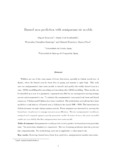Burned area prediction with semiparametric models

View/
Use this link to cite
http://hdl.handle.net/2183/16695
Except where otherwise noted, this item's license is described as Atribución-NoComercial-SinDerivadas 3.0 España
Collections
- Investigación (FIC) [1678]
Metadata
Show full item recordTitle
Burned area prediction with semiparametric modelsAuthor(s)
Date
2016-04-27Citation
Boubeta-Martínez, M.; Lombardía, M. J.; González-Manteiga, W. and Marey Pérez, Manuel F. (2016). "Burned area prediction with semiparametric models". International Journal of Wildland Fire
Abstract
[Abstract] Wildfires are one of the main causes of forest destruction, especially in Galicia (north-west Spain), where the area burned by forest fires in spring and summer is quite high. This work uses two semiparametric time-series models to describe and predict the weekly burned area in a year: autoregressive moving average (ARMA) modelling after smoothing, and smoothing after ARMA modelling. These models can be described as a sum of a parametric component modelled by an autoregressive moving average process and a non-parametric one. To estimate the non-parametric component, local linear and kernel regression, B-splines and P-splines were considered. The methodology and software were applied to a real dataset of burned area in Galicia for the period 1999–2008. The burned area in Galicia increases strongly during summer periods. Forest managers are interested in predicting the burned area to manage resources more efficiently. The two semiparametric models are analysed and compared with a purely parametric model. In terms of error, the most successful results are provided by the first semiparametric time-series model.
Keywords
Bootstrap
Burned area
Prediction
Semiparametric model
Time series
Forest fires
Burned area
Prediction
Semiparametric model
Time series
Forest fires
Editor version
Rights
Atribución-NoComercial-SinDerivadas 3.0 España
ISSN
1049-8001
1448-5516
1448-5516






